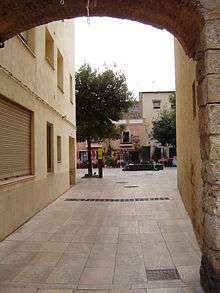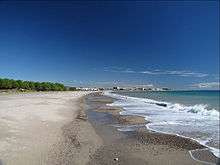L'Hospitalet de l'Infant
L'Hospitalet de l'Infant is a town based in the coast of Tarragona, inside the municipality of Vandellòs i l'Hospitalet de l'Infant, located in the south-west of Baix Camp in the region of Catalonia.

The center of the current population is on a rocky promontory flanked by an extensive beach called L'Arenal and crossed by the course of Llastres river now reduced to a torrent. At the top of this hill are the remains of the hospital built in the middle of fourteenth century (1344), the will of the child Pedro of Aragon and Anjou son of Jaume el Just and Blanca d'Anjou and who gave the town its name. The hospital Coll de Balaguer (as is mentioned in medieval documents) was built to provide accommodation for religious travelers and beggars who were crossing the route between Barcelona and Valencia, the route of the ancient Via Augusta Roman. In fact, mansion Oleastrum mentioned by ancient authors Antonino and Strabo has been located, since the end of the nineteenth century, as Hospitalet del Infante. Exists also the same name of the river Llastres (in Catalan Ullastres ', from the Latin' 'Oleaster' ') and references Avienus as' Oleum flumen 'the work' Ora maritima ', as the archaeological remains found in the Roman town.
The reasons for the foundation of the old Gothic hospital by Peter of Aragon, from the 1341 Lord county of Prades and the barony of Entença, prompted by the desire to establish bases for resettlement and economic revival of the area, and fortified by this construction ensure control of costs then exposed to frequent attacks by corsairs. The building was founded in 1344 and has a structure of about 55 square meters wide, with central courtyard flanked by six towers: four at the corners and two in the center of the north and south sides. The enclosure, an excellent example of Catalan Gothic civil buildings with large diaphragm arches crowned on the wooden beams that supported only be accessed by the existing door to the southern tower. The construction, which fulfills its mission of welcoming travelers to the early nineteenth century was involved, to be a fortress in the Catalan Civil War of sixteenth century in the Revolt (battle of the Coll de Balaguer, 1640), was the subject of pirate attacks and seriously affected during the French War, facts which implies impairment.
Currently, the hospital conserve just one of the four towers raised, the entrance to the Plaça del Pou, three walls and three Gothic arches rear courtyards of the houses that are on the inside.
Towers and fortifications
The hospital was founded by Infant Pere on 8th November 1344.
Situated in a passage near the old Via Augusta, its architecture is the result of the combination of their nursing care to the defense of the religion front incursions of the Saracens and the threat of bandits.
The fortified nature of the building is reflected in the walls of 11.7 meters, and the towers of 18 meters. Initially it was planned six, one in each corner and two in the middle of the northern and southern walls, although, apparently, it only made four. The building has no windows, except for remnants in the north-east and loopholes present around the perimeter.
Plaça del Pou

Access to the interior of the enclosure is made through a door located on the south side of the tower, and not the current access that leads to the Plaza Berenguer de Entença. This place is the modern urbanization of what was the courtyard of the old hospital, where, as the name suggests, was a well with a treadmill.
Tourism

Is one of the main economic activities of the town and the area represented by the regional brand Costa Daurada. The Local tourism brand is “L’Hospitalet de l’Infant i la Vall de Llors” L'Hospitalet de l'Infant has three beaches: L’Arenal, La Punta del Riu and El Torn and all of them have the EMAS certificate and the European Blue Flag.
Sant Roc Festivity and Hermitage
The Festival of l'Hospitalet de l'Infant are the Celebrations of Sant Roc, held in mid-August. The last day of such a popular walk is done to the hermitage of Sant Roc located about 5 km from the center of L'Hospitalet and 200m on the sea level. This building is located on the peak of the Serra del Mestral mountains, this area of 104m3 offers splendid views of the town and its coastline.
External links
Coordinates: 40°59′30.43″N 0°55′20.33″E / 40.9917861°N 0.9223139°E